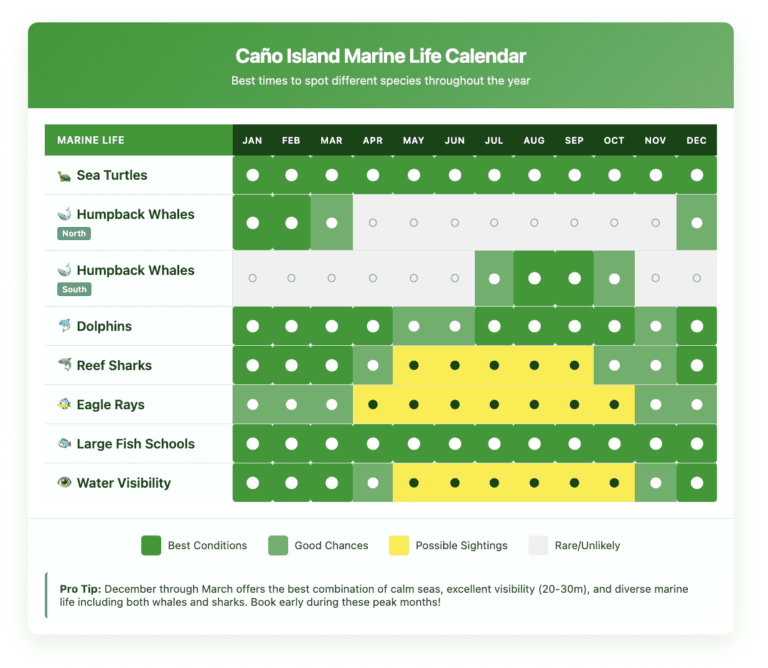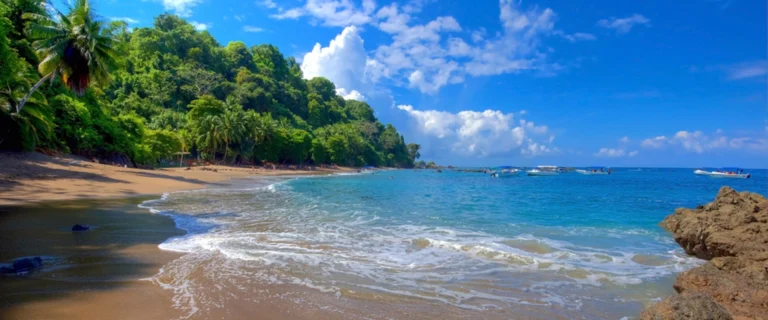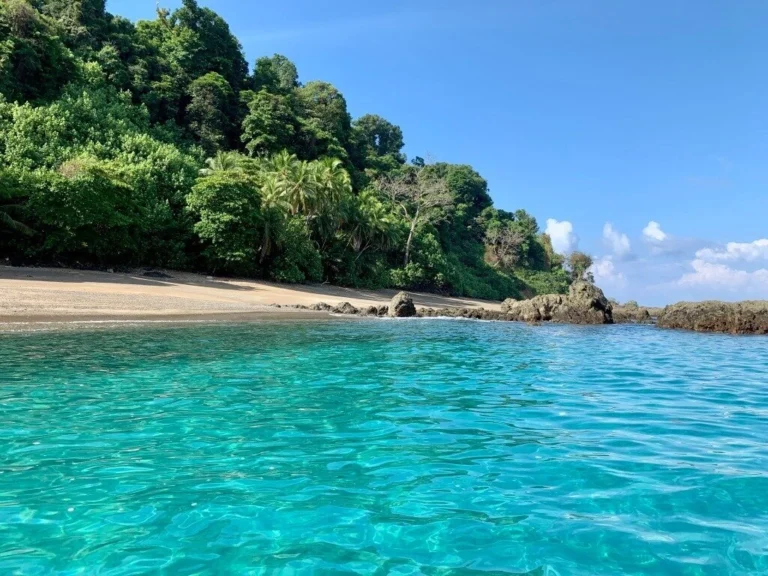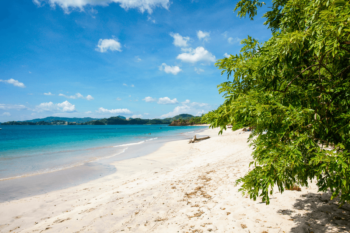Caño Island Snorkeling: What's Covered
Caño Island Biological Reserve sits 32 miles (52km) off Costa Rica’s southern Pacific coast near Uvita, offering exceptional snorkeling with crystal-clear visibility, sea turtles, massive schools of jacks, and colorful reef fish. Tours from Uvita cost $145 adults, $100 kids 3-11 (includes equipment, guide, lunch) departing 7am for 6-hour excursions with 1hr 15min boat ride each way. Best marine life viewing year-round with whale season July-October and December-March bringing humpback sightings. Driving to Uvita from San Jose Airport (SJO) takes 3-4 hours, positioning you for both Caño Island adventures and southern Pacific coast exploration.
Quick Facts:
- Location & Access: 52km offshore from Uvita; tours depart Punta Uvita dock; 3-4 hrs from San Jose, 4-5 hrs from Manuel Antonio
- Tour Details: $145 adults, $100 kids 3-11, free under 3; 6-hour excursion, two snorkel sessions at different reef sites, max 20 people per boat
- What’s Included: Boat transport, reserve entrance fees, bilingual guide, snorkel gear (mask/fins), life jackets (mandatory), water, fruit, snacks, lunch
- Boat Ride: 1hr 15min each way with frequent dolphin, sea turtle sightings; can be bumpy so anti-nausea medication recommended if prone to seasickness
- Marine Life: Exceptional visibility, hawksbill sea turtles, bigeye jacks, whitetip reef sharks, eagle rays, angelfish, parrotfish, trumpetfish; humpback whales seasonal
Top Snorkeling Experiences:
Tours from Uvita include two separate snorkel sessions exploring different reef areas around the biological reserve. Expect encounters with juvenile hawksbill turtles grazing peacefully on coral, massive shimmering schools of bigeye jacks creating underwater ballet, colorful reef fish (sergeant majors, angelfish, parrotfish), whitetip reef sharks hiding in crevices, and occasional eagle ray sightings. Crystal-clear underwater visibility reveals vibrant colors—surface may look dark but diving reveals stunning detail. Similar exceptional marine diversity to Tortuguero’s canal ecosystem but Pacific reef environment.
Essential Packing & Tips:
- Skin Protection: Wear rash guard preventing jellyfish stings, apply reef-safe sunscreen protecting coral ecosystem
- Waterproof Camera: Bring GoPro or waterproof camera capturing underwater encounters and memories
- Boat Comfort: Anti-nausea medication if seasickness-prone; 1hr 15min ride can be bumpy despite generally calm ocean
- Water Boarding: Wade into knee-deep water boarding boat; captains assist passengers
- What to Bring: Sandals/water shoes, comfortable boat clothes, change of clothes, swimsuit, reef-safe sunscreen, plastic/dry bag for belongings
- Tour Limitations: No bathroom facilities on boat, recommended for children 5+, life jackets mandatory for all participants
Meeting Point: Tours depart Punta Uvita; meet tour operator’s office downtown Uvita 7am (hotel transportation not included). Similar early departure timing as Caño Negro wildlife tours from La Fortuna.
Where to Stay in Uvita:
- Hotel Cuna del Angel – Spacious rooms off Costanera Sur highway, tranquil atmosphere, resident sloths on property
- Los Laureles Cabinas – Budget-friendly accommodations with on-site restaurant, nature trail, refreshing river access
- Manoas – Luxury glamping resort in mountains with villa options, stunning views, nearby river exploration
Combine with Southern Pacific Adventures: Most visitors pair Caño Island with Uvita’s whale watching (July-Oct, Dec-Mar), Marino Ballena National Park beach exploration, waterfall hikes, or continue north to Manuel Antonio National Park (2-3 hours). Uvita is 3-4 hours from San Jose Airport (SJO)—the closest international gateway for southern Pacific destinations. Learn about choosing the right Costa Rica airport based on your complete itinerary.
Best Season: Year-round excellent snorkeling with consistent visibility and marine life. July-October and December-March bring migrating humpback whales visible during boat rides (two different whale populations visit Costa Rica waters). Similar seasonal wildlife patterns to Manuel Antonio and other Pacific coast destinations.
Transportation Tips: Rent a car for flexibility exploring Uvita area attractions beyond Caño Island tours, or book shuttle services if relying on transportation. Uvita’s Costanera Sur highway provides easy access from San Jose, Manuel Antonio, or continue south to Osa Peninsula. Similar driving considerations to reaching other Pacific coast beach destinations.
If you need any help with a Costa Rica car rental, contact us now!
Caño Island delivers Costa Rica’s best underwater visibility with 20-30 meter clarity, making it ideal for spotting hawksbill turtles, massive schools of bigeye jacks, and whitetip reef sharks resting in coral crevices. Located 52 kilometers off the Pacific coast from Marino Ballena National Park, this biological reserve requires a 75-minute boat ride from Uvita—but the journey itself often features dolphin pods and seasonal humpback whale sightings. At $145 per adult for a full-day tour including two snorkel sessions, lunch, and gear, you’re getting access to protected waters where marine life thrives undisturbed.
Key Takeaways
- Crystal-clear visibility: 20-30 meters underwater clarity beats most Caribbean spots
- Marine life variety: Guaranteed sightings of sea turtles, jacks, angelfish, parrotfish, plus chances for reef sharks and eagle rays
- Two snorkel locations: Tours include stops at different sites around the island for varied experiences
- Boat ride bonus: Dolphin and whale sightings are common during the journey
- Full-day adventure: 6-hour tours include gear, lunch, snacks, and bilingual guides
- Strategic location: Easy day trip from Uvita, Dominical, or Ojochal with a rental car

What Makes Caño Island Different from Other Costa Rica Snorkeling Spots?
Caño Island (Isla del Caño) stands apart because it’s a protected biological reserve where fishing is prohibited, allowing marine populations to flourish naturally. The island sits at the convergence of ocean currents that bring nutrients up from deeper waters, creating perfect conditions for both small reef fish and larger pelagic species.
The water here stays clearer than in mainland spots because there’s no river runoff carrying sediment into the ocean. While places like Manuel Antonio or Tamarindo offer convenient beach snorkeling, they can’t match the visibility you’ll find 32 miles offshore.

Which Marine Animals Will You Actually See at Caño Island?
What Are Your Chances of Swimming with Sea Turtles?
Hawksbill and green sea turtles frequent the shallow reefs around Caño Island year-round. During morning snorkel sessions, you’ll typically spot juvenile hawksbills grazing on the coral formations at depths of 3-5 meters. These turtles have grown accustomed to snorkelers and often continue feeding while you float nearby.
The turtles surface every 20-30 minutes for air, giving you multiple opportunities for encounters during each snorkel stop. Your guide will know the specific coral heads where turtles regularly feed.
When Do the Big Schools of Fish Appear?
Massive schools of bigeye jacks patrol the waters around Caño Island throughout the day, but they’re most active during mid-morning when the current picks up. These silver clouds of fish can number in the thousands, creating a shimmering wall that parts as you swim through.
You’ll also encounter schools of yellowtail snapper, blue-striped grunts, and sergeant majors around the rocky outcroppings. The fish here show less fear of humans than at heavily fished areas, allowing for closer observation.
How Often Do People See Sharks and Rays?
Whitetip reef sharks rest in the sandy channels between coral formations, particularly at the deeper snorkel sites around the island’s north side. While not guaranteed, shark sightings happen on about 40% of tours, especially during the dry season (December through April) when visibility peaks.
Eagle rays and mobula rays pass through these waters regularly. Spotted eagle rays often cruise the sandy bottoms in groups of 3-5, while mobula rays appear more randomly, sometimes in schools of 20 or more.

What Should You Know About the Boat Journey to Caño Island?
How Rough Does the Ocean Get?
The Pacific Ocean between Uvita and Caño Island varies significantly by season. During the dry season, mornings typically offer calmer conditions with 1-2 foot swells. Green season (May through November) brings choppier conditions, especially in the afternoons.
The open boat design means you’ll feel the ocean’s movement. Sitting toward the back of the boat provides a smoother ride than the front, where you’ll catch more spray and bounce. Tour operators provide life jackets that you must wear during the journey.
What Wildlife Might You Spot During the Boat Ride?
The waters between the mainland and Caño Island serve as a marine highway for dolphins and whales. Spotted and spinner dolphins hunt in these waters year-round, often approaching boats to ride the bow wave.
Humpback whales migrate through these waters twice yearly—from December to March (Northern Hemisphere population) and July to October (Southern Hemisphere population). During peak whale season, sightings happen on roughly 70% of trips.
Which Tour Details Actually Matter for Planning?
What’s Included in the $145 Tour Price?
The standard Caño Island snorkeling tour from Uvita costs $145 for adults and $100 for children aged 3-11. This includes boat transportation, biological reserve entrance fees ($15 value), snorkel gear (mask, snorkel, fins), bilingual guide, lunch, fresh fruit, snacks, and drinking water.
Tours depart at 7:30 AM from Punta Uvita, with check-in at the tour operators’ offices in downtown Uvita at 7:00 AM. The full experience runs about 6 hours, returning to Uvita around 1:30-2:00 PM.
What Gear Should You Bring vs. What’s Provided?
Tour operators provide the essential snorkel equipment, but bringing your own mask ensures a proper fit if you wear glasses or have a smaller/larger face. Fins are included, though some snorkelers prefer their own for comfort.
You’ll want to bring a rash guard or long-sleeve swim shirt for sun and jellyfish protection. Reef-safe sunscreen is essential—regular sunscreen is prohibited in the biological reserve. A dry bag protects phones and cameras during the boat ride.

How Can You Avoid Common First-Timer Mistakes?
Why Does Everyone Recommend Taking Seasickness Medicine?
The 75-minute boat ride crosses open ocean where swells average 3-6 feet. Even travelers who don’t normally experience seamarine populations to flourish naturallysickness find the combination of diesel fumes, sun, and wave action challenging. Taking Dramamine or similar medication 30 minutes before departure prevents a miserable experience.
Eat a light breakfast with some carbohydrates—completely empty stomachs make seasickness worse. Avoid coffee and acidic fruits before the trip. Focus on the horizon during the ride rather than looking down at your phone.
What’s the Deal with Jellyfish Stings?
Small, transparent jellyfish float through Caño Island waters, particularly during the green season. Their stings feel like tiny electric shocks—not dangerous but definitely annoying. A rash guard or dive skin prevents most stings on your torso and arms.
If you do get stung, the boat crew carries vinegar, which neutralizes the stinging cells. Don’t scratch the affected area, as this spreads the irritation.
Where Should You Stay for Easy Access to Caño Island Tours?
Which Uvita Hotels Make Morning Tours Convenient?
Hotel Cuna del Angel (4.5 rating on TripAdvisor) sits just 5 minutes from downtown Uvit, where tours depart. Their rooms include air conditioning, strong WiFi, and a pool area where three-toed sloths regularly appear in the surrounding trees. The hotel’s restaurant opens at 6:00 AM, perfect timing for tour departures.
Tiki Villas Rainforest Lodge (4.5 rating) offers boutique bungalows 10 minutes from Uvita center. Each villa has a full kitchen, making it easy to pack snacks for your tour. The property’s elevation keeps it cooler than beachfront hotels.
What Are the Best Budget-Friendly Options Near Uvita?
Cascada Verde Hostel (4.6 rating) provides both dorms and private rooms within walking distance of Uvita center. Their communal kitchen opens at 5:30 AM, and they’ll store your leftover luggage while you’re on the tour.
Flutterby House (4.4 rating) combines hostel prices with hotel amenities, including a pool and yoga deck. Located between Uvita and Dominical, it’s a 15-minute drive to tour departure points—having a rental car makes this a great value option.

How Does Having a Rental Car Improve Your Caño Island Experience?
Starting your Caño Island adventure from San José? The drive to Uvita takes about 3 hours via Route 27 and the Costanera Sur. With your own vehicle, you can leave the capital at 4:00 AM and still make the 7:00 AM tour check-in, saving a night’s accommodation cost.
A rental car also opens up afternoon activities after your snorkeling tour. The famous Whale Tail at Marino Ballena National Park is just 10 minutes from where the tours return. Nauyaca Waterfalls, one of Costa Rica’s most impressive cascades, sits 20 minutes inland from Uvita.
Having your own transportation means you can stock up on reef-safe sunscreen, seasickness medication, and snacks at the Uvita BM Supermarket before your tour. The AutoMercado in Coronado (on your way from San José) carries waterproof phone cases and dry bags if you forgot to pack them.
What’s Your Next Step for Booking a Caño Island Snorkeling Adventure?
Book your tour at least 2-3 days in advance during high season (December through April) when boats fill quickly. The green season offers more flexibility, often allowing next-day bookings. Contact tour operators directly in Uvita rather than booking through hotels, which typically add a 20% markup.
Plan to arrive in Uvita the afternoon before your tour to settle in and prepare your gear. Pick up any last-minute supplies and get a good night’s rest—you’ll be up early for check-in.
Ready to explore Caño Island and the Southern Pacific region at your own pace? Vamos Rent-A-Car provides reliable 4×4 vehicles perfect for navigating the coastal and mountain routes around Uvita, ensuring you can maximize your time before and after your snorkeling adventure.

Frequently Asked Questions
How do you get to Caño Island, Costa Rica?
You’ll take a boat from one of three departure points: Uvita (75 minutes), Drake Bay (45 minutes), or Sierpe (90 minutes). Most visitors choose Uvita since it’s accessible via the Costanera Sur highway and offers the most tour options. Tours depart around 7:30 AM, so if you’re driving from San José, leave by 4:00 AM to make the check-in time. Having a rental car lets you explore the Marino Ballena area before and after your tour—the famous Whale Tail is just 10 minutes from where boats return.
What animals are on Caño Island, Costa Rica?
The waters around Caño Island host hawksbill and green sea turtles year-round, massive schools of bigeye jacks, yellowtail snappers, and sergeant majors. Whitetip reef sharks rest in the sandy channels on about 40% of tours. Eagle rays cruise the sandy bottoms in groups of 3-5, while spotted dolphins frequently approach boats during the journey. Humpback whales pass through twice yearly—December to March and July to October. On the island itself (which you don’t visit during snorkel tours), there are boa constrictors, pacas, and various bird species.
How long is the boat ride to Caño Island?
From Uvita, the boat ride takes 75 minutes each way across the open ocean. Expect 3-6 foot swells, depending on the season—calmer from December through April, choppier from May through November. The boats are open-design with mandatory life jackets, and you’ll feel every wave. Sitting toward the back provides a smoother ride than the front. Take seasickness medication 30 minutes before departure, even if you don’t normally get seasick—the combination of diesel fumes, sun, and waves affects most people.
How deep is the snorkeling at Caño Island?
Snorkeling depths range from 3-8 meters (10-26 feet) at most sites, though the ocean floor drops to 15-20 meters in some areas. You’ll stay at the surface with your snorkel, but the incredible 20-30 meter horizontal visibility lets you see everything below. Sea turtles feed on shallow reefs at 3-5 meters, while reef sharks rest in deeper channels at 8-10 meters—both easily visible from the surface. The tour provides life jackets, which are mandatory, so you don’t need to worry about treading water.
Is Caño Island snorkeling suitable for beginners?
Yes, if you’re comfortable in open water and can handle the boat ride. The snorkeling itself is easy—you float on the surface wearing a mandatory life jacket while looking down at the marine life. However, you need to board the boat from knee-deep water at the beach, manage 75 minutes of open ocean travel, and be okay with deep water where you can’t see or touch the bottom. Tours require participants to be at least 5 years old, though most operators recommend age 8+ for the best experience.
What’s the best month to snorkel at Caño Island?
December through March offers the ideal combination: calm seas, 25-30 meter visibility, active reef sharks, and migrating humpback whales from the Northern Hemisphere. January and February are peak months with the clearest water. July through October brings the Southern Hemisphere humpback whales, but choppier conditions. Avoid September and October when rain reduces visibility. Book 2-3 days ahead during high season (December-April) when tours fill quickly.
Can you swim at Caño Island beaches?
Swimming isn’t allowed at Caño Island’s beaches since it’s a protected biological reserve. Snorkeling happens at designated sites around the island where boats anchor in deeper water. You’ll snorkel at two different locations during the tour, spending about 45 minutes at each spot, but you never actually set foot on the island. The only beach time is at the departure point in Uvita before boarding and after returning from the tour.
Is the Caño Island tour worth the price?
At $145 per adult, you’re paying for access to Costa Rica’s best snorkeling with 20-30 meter visibility and guaranteed wildlife sightings. The price includes $15 in park fees, all equipment, lunch, guides, and 90 minutes of snorkeling at two different sites. Compare this to Caribbean snorkeling, where visibility rarely exceeds 15 meters, and you’ll understand the value. The boat ride alone often includes dolphin sightings and seasonal whale encounters. For underwater photography enthusiasts or anyone who wants to see sea turtles and tropical fish in crystal-clear water, it’s worth every dollar.




